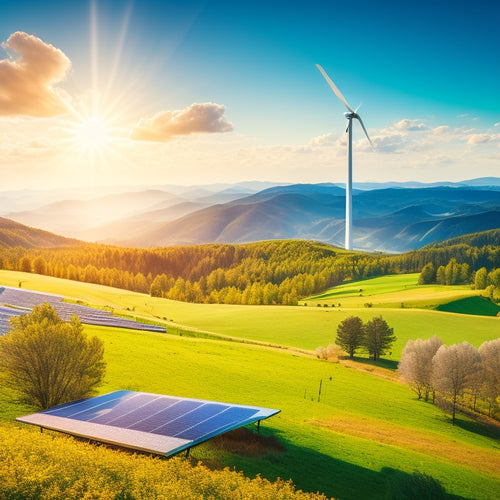
Diy Solar Panels for Sale
Share
By investing in DIY solar panels, you can cut your energy bills by 50-75% and reduce your carbon footprint. High-efficiency monocrystalline cells maximize power output, and with proper installation, you can achieve zero energy bills by covering your energy needs. When considering DIY solar panels for sale, factor in your roof's square footage, ideal panel tilt, and shading issues to optimize energy output. Extended warranty periods guarantee peace of mind for your investment. As you investigate the world of DIY solar panels, you'll find that the right combination of technology, installation, and protection can lead you down a path to sustainable energy independence and significant cost savings.
The Essentials
- DIY solar panel kits help combat high electricity bills by generating clean, sustainable power and reducing grid reliance.
- High-efficiency solar panels maximize energy production, with ratings ranging from 15% to 22% for various applications.
- Proper installation of DIY solar panels is crucial, considering factors like panel orientation, tilt, and shading to ensure optimal energy output.
- DIY solar panels can lead to significant energy savings, cutting energy bills by 50-75%, and potentially achieving zero energy bills.
- Extended protection plans and longer warranty periods offer peace of mind for DIY solar panel investments, protecting against defects and repair costs.
Renewable Energy Independence Now
You're taking the first step towards utilizing natural energy sources, reducing your reliance on the grid and gaining control over your energy costs.
By converting sunlight into electrical energy, you'll break free from the constraints of traditional power sources and enjoy the benefits of renewable energy independence.
With a DIY solar panel kit, you can overcome common barriers such as high electricity bills and limited grid connection in remote areas, and instead, generate clean, sustainable power and greatly reduce your carbon footprint.
Harness Natural Energy Sources
Renewable energy sources, such as solar power, wind power, and hydro power, offer a cleaner, more sustainable alternative to fossil fuels, allowing you to tap into nature's abundance and reduce your reliance on the grid.
By utilizing natural energy sources, you're not only decreasing your carbon footprint but also contributing to a sustainable future. With solar panels, you can generate power and reduce your energy bills.
Furthermore, adopting sustainability practices and eco-friendly solutions can greatly minimize environmental impact. By considering DIY solar kits and renewable energy systems, you can empower your home with a cost-effective alternative to traditional energy sources.
The energy shift we're experiencing is vital in combating climate change, and renewable innovations are leading the way. By embracing green technology, you're supporting a cleaner, healthier planet.
As you consider DIY solar panels, remember that you're investing in a renewable energy source that's not only good for the environment but also for your wallet.
Break Free From Grid
By utilizing natural energy sources, you've taken the first step towards breaking free from grid dependence. Now, it's time to develop a thorough strategy for achieving grid independence.
A well-designed home solar kit can address common concerns such as high upfront costs and limited energy storage capabilities, making it easier to shift to renewable energy. A well-planned solar panel installation is essential in your quest for energy autonomy. Assess your energy requirements and determine the number of solar panels needed to meet your daily needs.
Make sure your solar panel installation is optimized for maximum energy harvesting by considering factors such as panel angle, direction, and shading.
To further enhance your grid independence, implement energy-saving strategies in your daily routine. Replace traditional incandescent bulbs with energy-efficient LED lighting, and optimize your appliances for minimal energy consumption.
Developing a strong grid independence strategy requires careful planning and execution. By combining solar power with energy-efficient practices, you'll be well on your way to breaking free from the grid.
Enjoy the freedom and self-sufficiency that comes with generating your own renewable energy!
Zero Energy Bills Guaranteed
You're about to experience the thrill of zero energy bills guaranteed, where your DIY solar panels generate enough power to cover your energy needs, resulting in significant energy savings now.
By utilizing the power of renewable energy solar power systems, you'll not only reduce your carbon footprint but also contribute to a sustainable living environment.
With your solar panel system producing clean energy, you'll drastically reduce your reliance on the grid, ultimately leading to zero electricity cost.
Energy Savings Now
Installing DIY solar panels can slash your energy bills dramatically, and in some cases, even eliminate them altogether.
You'll be amazed at how much you can save by utilizing the power of the sun. A thorough cost analysis will help you determine the exact amount you'll save, but on average, homeowners who install DIY solar panels see a reduction of 50-75% on their energy bills.
To maximize your energy savings, it's crucial to follow proper installation tips. Ascertain your solar panels are installed at an ideal angle and direction to capture the most sunlight.
Additionally, consider the type of solar panels you're using and their efficiency rating. High-efficiency panels may cost more, but they'll generate more power per hour of sunlight.
Zero Electricity Cost
One of the most significant benefits of DIY solar panels is the potential to eliminate energy bills altogether.
With a well-designed solar panel installation, you can reduce your energy consumption to zero, effectively cutting your electricity costs to nothing. This means you'll no longer be reliant on the grid, and you'll have complete control over your energy usage.
To achieve zero electricity cost, you'll need to guarantee your solar panel system is sized correctly to meet your energy needs.
This involves evaluating your energy consumption patterns and determining the right number of panels required to generate enough power.
High-Efficiency Monocrystalline Cells
You're likely familiar with the importance of high-efficiency cells in maximizing your DIY solar panel's power output.
When it comes to residential solar energy systems, high-efficiency cells play an essential role in reducing your carbon footprint and electricity bills.
Monocrystalline cells, in particular, showcase impressive cell efficiency ratings, with some models reaching up to 23% or higher.
Cell Efficiency Ratings
As solar panels become increasingly efficient, manufacturers are touting high-efficiency monocrystalline cells as the key to releasing maximum energy output. You're likely wondering what makes these cells so special. The answer lies in their cell efficiency ratings.
These ratings determine how well a cell converts sunlight into electricity. You'll typically see efficiency ratings ranging from 15% to 22%. But what does that really mean?
| Efficiency Rating | Cell Performance |
|---|---|
| 15% | Good for small-scale systems, but less efficient |
| 18% | Suitable for residential installations, offering a balance between cost and performance |
| 22% | Ideal for large-scale commercial projects, providing maximum energy output |
When comparing cell efficiency, you'll notice that higher ratings don't always translate to better performance. Other factors like temperature coefficient, fill factor, and open-circuit voltage also impact cell performance. As you investigate DIY solar panel options, keep in mind that high-efficiency monocrystalline cells may offer superior efficiency comparison, but they come at a higher cost. Weigh your options carefully to find the best fit for your energy needs and budget.
Power Output Boost
High-efficiency monocrystalline cells boast a significant power output enhancement, which makes them an attractive option for solar panels.
You'll notice a substantial increase in energy production with these high-performance cells. This means you'll generate more power per hour of sunlight, translating to reduced energy costs and a faster return on investment.
When you opt for high-efficiency monocrystalline cells, you'll benefit from improved solar panel maintenance.
These cells are more resistant to heat and degradation, ensuring your system operates efficiently over its lifespan. This reduced degradation rate also means you'll require less frequent cleaning and replacement, saving you time and resources.
To maximize your energy independence, consider pairing your high-efficiency solar panel system with energy storage solutions.
By storing excess energy generated during the day for use during the night or on cloudy days, you'll enjoy a reliable and consistent supply of clean energy.
With high-efficiency monocrystalline cells and energy storage, you'll be well on your way to achieving energy freedom.
Consider Roof Size Constraints
When planning your DIY solar panel project, you'll need to evaluate your roof's available space to determine how many panels you can install.
Since panel orientation affects energy output, you'll also need to take into account the direction your roof faces and how that impacts your panel layout.
Additionally, it's crucial to take into account off-grid solar kits and how they can provide backup power during outages, making your system more efficient.
Roof Space Availability
Your roof's real estate is a precious commodity for DIY solar panels, and its limited space demands careful consideration. When evaluating your roof's space availability, you'll need to assess its size, shape, and obstacles.
Start by calculating your roof's square footage, factoring in any obstructions like vents, skylights, or chimneys. Next, consider the roof pitch – a steeper pitch may limit the number of panels you can install.
Shading issues also play a significant role in determining usable roof space. Identify areas that receive consistent shade, whether from trees, buildings, or other structures, and incorporate those into your calculations.
To maximize your roof's potential, you may need to strategically position panels around these obstacles. Don't forget to account for necessary clearances, such as those between panels and around edges.
Panel Orientation Matters
Having assessed your roof's space constraints, you're now ready to evaluate the impact of panel orientation on your DIY solar panel installation.
Panel orientation greatly affects the overall energy output of your solar panel system. The ideal panel tilt is between 30-40 degrees, allowing for the best sunlight exposure. However, this may not be feasible for all roofs, especially those with limited space.
You'll need to take into account the trade-off between panel tilt and roof space. A steeper tilt may improve winter performance but reduce summer performance, while a shallower tilt may increase summer performance but compromise winter performance.
Additionally, you'll need to verify that your panels are installed at an orientation that minimizes shading from surrounding structures or trees.
When determining the best panel orientation, consider your location's latitude and the time of year. In the northern hemisphere, a south-facing orientation is ideal, while in the southern hemisphere, a north-facing orientation is best.
Longer Warranty Period Guaranteed
When you invest in DIY solar panels, you're not just buying a product - you're buying peace of mind.
That's why you should look for manufacturers that offer an extended protection plan, which can provide you with a longer warranty period guaranteed.
This means you'll be protected against defects, repairs, and replacements for an extended period, giving you more confidence in your solar panel system.
Extended Protection Plan
The manufacturer's extended protection plan offers an additional layer of security for your DIY solar panel system, guaranteeing a longer warranty period and providing peace of mind for your investment.
This plan is designed to give you extra protection coverage beyond the standard warranty, ensuring you're protected from unexpected repair or replacement costs. With an extended warranty, you'll have confidence that your system will continue to generate clean energy for years to come.
When you purchase an extended protection plan, you'll get a longer warranty period, typically up to 25 years or more, depending on the manufacturer.
This means you'll have more time to enjoy the benefits of your DIY solar panel system without worrying about the financial burden of unexpected repairs. The plan also covers parts and labor, so you won't have to pay out-of-pocket for repairs or replacements.
Frequently Asked Questions
Can I Install DIY Solar Panels Myself Without Professional Help?
You can install DIY solar panels yourself, but you'll need to take safety precautions, like wearing protective gear and ensuring a stable roof structure, and have the necessary tools, such as a drill and wire strippers, to complete the job successfully.
Are There Any Government Incentives for DIY Solar Panel Installation?
You're sitting on a goldmine of savings! When you install DIY solar panels, you're eligible for incredible tax credits, supporting renewable energy and your independence. Claim up to 26% of your installation costs back – it's a freedom fighter's dream come true!
How Long Does It Take to Assemble and Install DIY Solar Panels?
You'll spend around 2-5 days on assembly time, depending on the system size, and another 1-3 days for installation, following expert installation tips to guarantee a secure and efficient setup that gives you the freedom to utilize renewable energy.
Can I Use DIY Solar Panels to Charge My Electric Vehicle?
You can charge your electric vehicle with DIY solar panels, but it's essential to take into account charging efficiency and choose the right solar panel types, like high-efficiency monocrystalline or bifacial panels, to maximize energy output and minimize charging time.
Are DIY Solar Panels Compatible With Existing Electrical Systems?
You'll find that most DIY solar panels are compatible with existing electrical systems, but you'll need to verify the panel's efficiency meets your energy demands and follow installation guidelines to avoid electrical shocks or fires.
Final Thoughts
With your DIY solar panels, you'll be saving a fortune on energy bills in no time! You'll be generating enough electricity to power a small town - okay, maybe not that much, but you get the idea! With high-efficiency monocrystalline cells and a longer warranty period guaranteed, you can rest assured you're making a smart investment. Just consider your roof size constraints and you're all set for renewable energy independence. Say goodbye to zero energy bills and hello to a sustainable future!
Related Posts
-

Renewable Energy Solutions to Reduce Your Carbon Footprint
To reduce your carbon footprint, adopting renewable energy solutions is key. Using solar panels or wind turbines can ...
-

Solar Powered Lights for Sustainable Home Decor
Solar-powered lights offer a stylish and eco-friendly way to enhance your home decor. They capture sunlight, converti...
-

Essential Hiking Lights for Safety and Fun
When you're hitting the trails, essential hiking lights are vital for safety and fun. A lightweight headlamp offers h...


